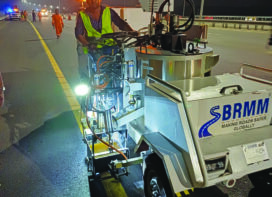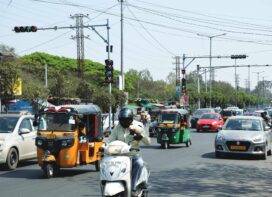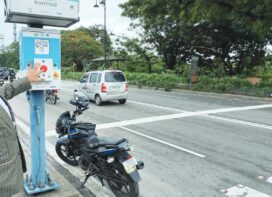The challenges of ETC implementation
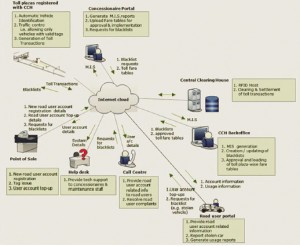 A significant challenge lies in minimizing the set-up and operation costs to provide road user with affordable tariff but, at the same time generate more net revenue. If operating costs are a high proportion of revenue, ETC program can turn out to be less efficient than other forms of revenue or tax collection. In addition, with the transport authority transferring maximum technical and operational risk to the operator or concessionaire, the cost issue becomes even more fundamental. An interoperable ETC business model involves multiple service providers and increases both costs and risks and therefore most likely to work well where there is large traffic volume and demand for regional interoperability. Mentioning some technical/operational hiccups, Sharma stated, “Non –ETC Users coming in ETC lanes as well as users with insufficient balances may come in ETC lanes thereby hampering the flow of traffic. Since the E- lanes are mostly unmanned, instances of gate crashing may occur. Till such time that sufficient ETC Users are available, dedicating lanes to ETC Users will be a challenge, more so at toll plazas where the number of lanes are limited.”
A significant challenge lies in minimizing the set-up and operation costs to provide road user with affordable tariff but, at the same time generate more net revenue. If operating costs are a high proportion of revenue, ETC program can turn out to be less efficient than other forms of revenue or tax collection. In addition, with the transport authority transferring maximum technical and operational risk to the operator or concessionaire, the cost issue becomes even more fundamental. An interoperable ETC business model involves multiple service providers and increases both costs and risks and therefore most likely to work well where there is large traffic volume and demand for regional interoperability. Mentioning some technical/operational hiccups, Sharma stated, “Non –ETC Users coming in ETC lanes as well as users with insufficient balances may come in ETC lanes thereby hampering the flow of traffic. Since the E- lanes are mostly unmanned, instances of gate crashing may occur. Till such time that sufficient ETC Users are available, dedicating lanes to ETC Users will be a challenge, more so at toll plazas where the number of lanes are limited.”
Cost Factor
Some of the factors that may have large impact include, identifying the lowest cost ETC technology, studying different vehicle mixes, trip patterns, frequency of trips and volume of traffic on tolled roads as well as enforcement process. Other significant cost reduction aspects comprise:
- On Board Unit (OBU) –RFID ‘sticker tags’ reduce costs substantially. Significant developments in vehicle telematics are also driving down the cost of technology.
- Road-side equipment –DSRC/tag readers, vehicle classifiers and cameras are expensive, although unit costs can fall with wider deployment.
- Back office –Digital channels for billing and payment and reduced service provider/merchant acquirer fees can help systems cheaper to operate and maintain.
- Enforcement operations – Interoperability across tolls, shared datasets and coordinated enforcement arrangements offer cost benefits in the long run.
Briefing on the steps taken to address some of these challenges, Ravi Palekar, CEO, IHMCL said. “Earlier NHAI had engaged ICICI Bank and Axis bank as issuers to distribute RFID based tag and for providing Central Clearing House (CCH) services. However, the system did not work out as a financially viable option and therefore, NHAI approached the National Payments Corporation of India (NPCI) to set up an interbank clearing house to enable e-tolling.
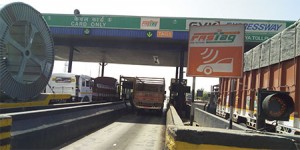 Once, NPCI interbank clearing system becomes operable, all banks who are interested to be part of the scheme, can either become the issuer bank of tolling cards to the vehicle owners, an acquirer bank for making payment to the toll operators or both. Apart from the RIFD tags being available at the kiosks located at the Toll Plazas, they would also be available at other convenient locations like petrol pump stations, issuer banks branches and mobile units. The interested road users can request for the RFID tags using email, telephone, Mobile app or through bank’s websites. This model will not only provide convenience to the end user offering many points of sales for the RFID tag but also bring competitiveness and transparency in the system. As per the financial arrangement, the issuer bank will receive 1.50%, acquirer bank 1.25% and NPCI 0.25% of the of ETC revenue collection.”
Once, NPCI interbank clearing system becomes operable, all banks who are interested to be part of the scheme, can either become the issuer bank of tolling cards to the vehicle owners, an acquirer bank for making payment to the toll operators or both. Apart from the RIFD tags being available at the kiosks located at the Toll Plazas, they would also be available at other convenient locations like petrol pump stations, issuer banks branches and mobile units. The interested road users can request for the RFID tags using email, telephone, Mobile app or through bank’s websites. This model will not only provide convenience to the end user offering many points of sales for the RFID tag but also bring competitiveness and transparency in the system. As per the financial arrangement, the issuer bank will receive 1.50%, acquirer bank 1.25% and NPCI 0.25% of the of ETC revenue collection.”
The Potential Benefits
Unlike developed countries where the ETC system has been in place for quite some time, India has a distinct advantage of not dealing with legacy systems and hard to integrate obsolete technologies. Thus, authorities have been able to adopt robust ETC technology which is scalable, interoperable and inexpensive to the road users. Palekar elaborated, “While developed countries that have Electronic Toll Collection (ETC) in place for quite some time are struggling to achieve interoperability between toll plazas/operators due to legacy systems, in countries like Malaysia, Taiwan etc. that have recently introduced modern ETC systems, the number of toll plazas covered are few given the size of the countries. In comparison, the nationwide ETC in India would be the first of its kind worldwide, given the geographical spread, the number of toll plazas and the length of highways.”
 “The interested road users can request for the RFID tags using email, telephone, Mobile app or through bank’s websites. This model will not only provide convenience to the end user offering many points of sales for the RFID tag but also bring competitiveness and transparency in the system.”
“The interested road users can request for the RFID tags using email, telephone, Mobile app or through bank’s websites. This model will not only provide convenience to the end user offering many points of sales for the RFID tag but also bring competitiveness and transparency in the system.”
– Ravi Palekar
Advantage for Road Users
- Less traffic congestion
- Reduced or negligent waiting time at tolls
- Fuel saving
- Convenience for payment of toll
- Toll statements available online
Advantage for Toll Concessionaire
- Lower Operating Costs.
- Better audit control through centralized user accounts.
- Expanded capacity without extra infrastructure.
- Minimized manual leakage
- No cash management and safety issues
Advantage for government
- Reduction in fuel consumption
- Reduction of vehicle emissions
- Transparency in toll transactions
- Increased revenues
 TrafficInfraTech Magazine Linking People Places & Progress
TrafficInfraTech Magazine Linking People Places & Progress
